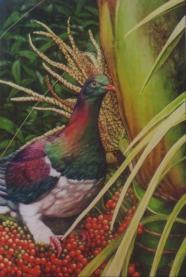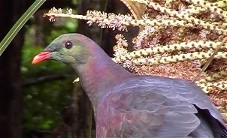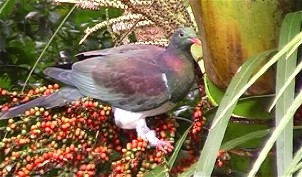 New Zealand's Native
Wood Pigeon New Zealand's Native
Wood PigeonMaori Name: Kereru, Kuku, Kukupa Scientific Name: Hemiphaga novaeseelandiae Painting (at left) Paula Novak (Istra) 2002 (C) See selections of Paula's art here or go to her website www.istra-artworks.com Photographs: Keith Newman The New Zealand
native Wood
Pigeon is distinguished by its size, its distinctive colouring of white
chest with purple, blue and green body and its size.
You can hear this bird coming by the swoosh
swoosh sound of its flight and the unmistakable bowing of lighter
branches as it parks itself in native trees. To the early Maori the kereru was a delicacy but is now a protected bird and considered endangered. Unlike other birds such as ducks or pukeko, kereru only produce one egg each year - even in a good season. According to the Royal forest & Bird Protection Society this egg is incubated for one month and doesn't fledge for another 4-6 weeks. During this time the chick is dependent on both its parents, and is highly vulnerable to predation. Possums can eat their eggs and the berries and fruit they thrive on. Magpies and mynas sometimes attack them scaring them from their nest. Although able to live
up to 15 years on offshore islands, introduced predators Undigested seeds eaten by the kereru fall to the ground in its droppings, where they sprout and grow - often many kilometres from the parent tree. These birds can fly long distances (up to 25 kilometres). This spreads the seeds of native species far and wide, helping our native forests to regenerate. - Compiled by Keith Newman |
|
|

 have reduced their expected lifespan to an average of 5-6 years on
the mainland. This is often reduced to about 3 years where illegal
hunting pressure occurs. In one forest where there was extensive
evidence of poaching, the decline was a staggering 70 per cent between
1979 - 1993. With only 10-15 per cent nesting success rate, many birds
are dying before they can reproduce.
have reduced their expected lifespan to an average of 5-6 years on
the mainland. This is often reduced to about 3 years where illegal
hunting pressure occurs. In one forest where there was extensive
evidence of poaching, the decline was a staggering 70 per cent between
1979 - 1993. With only 10-15 per cent nesting success rate, many birds
are dying before they can reproduce.